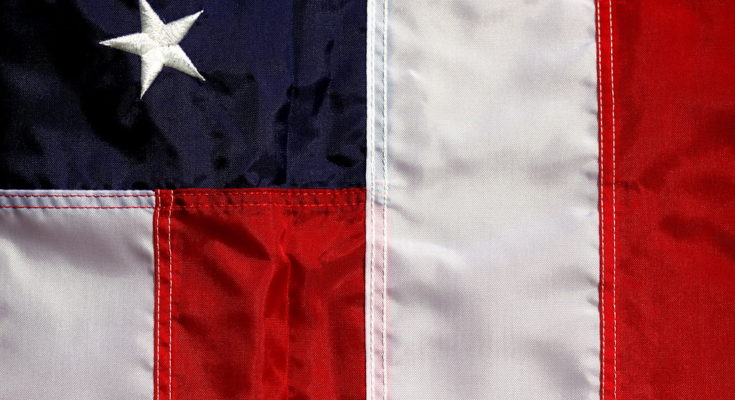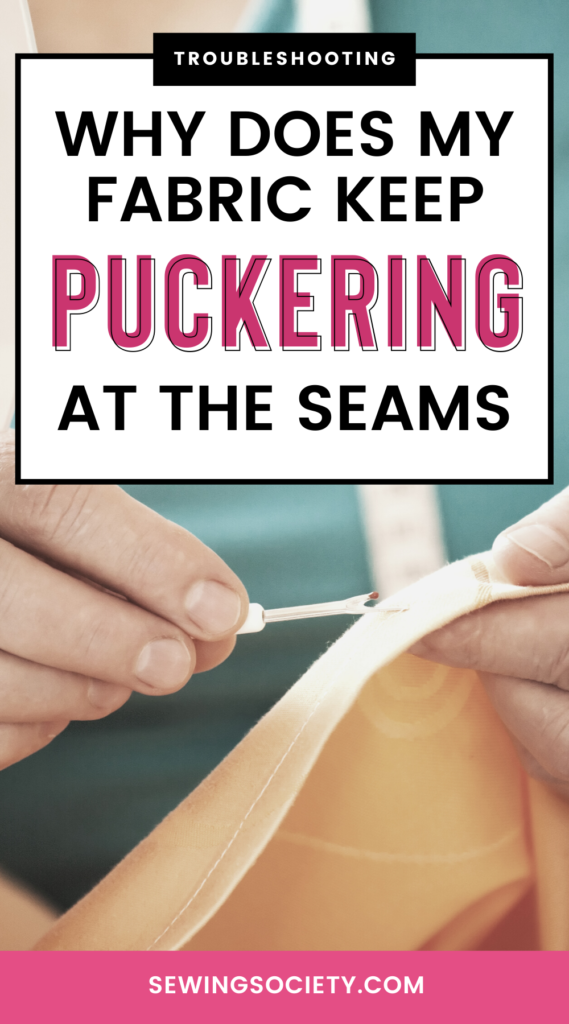Disclosure: This post may contain affiliate links. I earn a small commission when you click a link and make a purchase. Thanks for supporting SewingSociety.com!
Nothing makes a garment look more handmade than puckered seams. Your seams should lay flat with even looping on both sides. Here are nine reasons why fabric can pucker at the seams, and what to do about each one.
Contents
Your Sewing Machine Is Not Threaded Correctly
Even people who have been sewing for years sometimes thread their sewing machines incorrectly. This is the first thing you should check if your sewing machine is not working properly or your stitches are puckering.
Unthread your sewing machine and rethread it from the beginning. Ensure your thread take-up lever is in its highest position, attach your spool of thread, and then pull your thread through your tension discs and thread guides according to the instructions in your user manual. Then, pull your thread through the eye of your needle and leave a four-inch tail of thread.
Your Thread Tension Is Too Tight
Your thread tension should be adjusted for different weights of fabric and thread. Make sure that you are using the same weight thread in both your bobbin and upper thread. If you don’t, your tension can be uneven and cause your seams to pucker. If the loops are larger on the bottom, you need to adjust your upper thread tension. It might be too tight. Make small adjustments to your tension until your stitches look even and the puckering stops.
Sewing machine manufacturers suggest that you don’t mess with your bobbin thread tension too much, but you should adjust your upper thread tension if your seams are puckering. If your tension gets too tight, it can pull your thread and break it. Turn your tension dial counterclockwise to loosen it. If you can’t seem to get your tension right, a sewing machine repair technician can reset your bobbin tension.
Your Needle Is Damaged, Bent, or Dull
You’re supposed to change the needle on your sewing machine frequently so it stays sharp and can easily pierce through your fabric. If your needle has gone dull, it might snag and cause your fabric to pucker at the seams. You might even hear a popping noise as your needle enters your fabric. A dull needle can also push your fabric into your bobbin case and cause a jam. This is worse than a pucker. Try replacing your needle to see if the puckering goes away.
Sewing machine needles also have natural flaws or burs that happen during manufacturing. You will occasionally come across a needle that is bent or damaged before you insert it into your machine. This isn’t very common, but it does happen. It’s a good idea to always have replacement sewing machine needles on hand.
You Are Using the Wrong Type of Bobbin Thread
When possible, use the same thread in your bobbin as you are using in the upper portion of your sewing machine. If your upper thread and bobbin thread are different weights, this can cause puckering in your fabric while you sew. Watch out for this if you have a sewing/embroidery machine combo because you can forget to remove your embroidery thread bobbin.
Your Bobbin Case Is Full of Lint
Lint builds up in your bobbin case as you sew. It can get in the way of your needle and prevent the hook in your bobbin case from forming stitches properly. Clean your sewing machine frequently to ensure you don’t get puckered seams.
Your Stitch Length Is Too Long
Sometimes puckering is the result of using a stitch that is too long for your fabric. Certain fabrics, such as organza and silk, cannot handle long stitches without puckering. Use a shorter stitch length to solve the problem, but don’t make it so short that you cause other problems. Also, avoid using a zigzag stitch on fabric that puckers easily.
Your Presser Foot Pressure Is Too Low
You can adjust your presser foot pressure to accommodate different types of fabric. For example, you should loosen the pressure for leather and corduroy, and increase the pressure for organza and silk. If your presser foot pressure is too low, it can cause puckering in your fabric because your fabric might not feed through your sewing machine evenly. A walking foot attachment can also help pull your fabric through your sewing machine more evenly and prevent puckering.
Your Fabric Is Too Stretchy, Slippery, or Thin
Silk and organza are susceptible to puckered seams, but this is also true of any sheer, slippery, or stretchy fabric. Use stabilizer or interfacing with slippery or thin fabrics to make your stitches form more evenly.
You Are Pulling on Your Fabric While You Sew
Fabric can pucker at the seams if you are pulling on it while you sew. Never push or pull your fabric through your sewing machine. Your feed dogs and presser foot are meant to work together to feed your fabric through your sewing machine evenly for you.
Did you find this article helpful?
I can help you solve other sewing machine problems, too! Get a copy of my book, Sewing Machine Problems and How to Solve Them on Amazon.
Your sewing machine is going to give you troubles again.
It’s inevitable…
My troubleshooting book walks you through how to solve the 20 most common sewing machine problems. You’ll be prepared to tackle any problem your sewing machine throws at you. That means more time sewing and less time crying.
The ebook version only costs $2.99. You’d easily pay between $75 and $150 to take your sewing machine to a repair technician. Learn how to do a lot of the sewing machine troubleshooting yourself and save money.
For more information, visit our Sewing Machine Troubleshooting Page.
Share this post on Pinterest!






